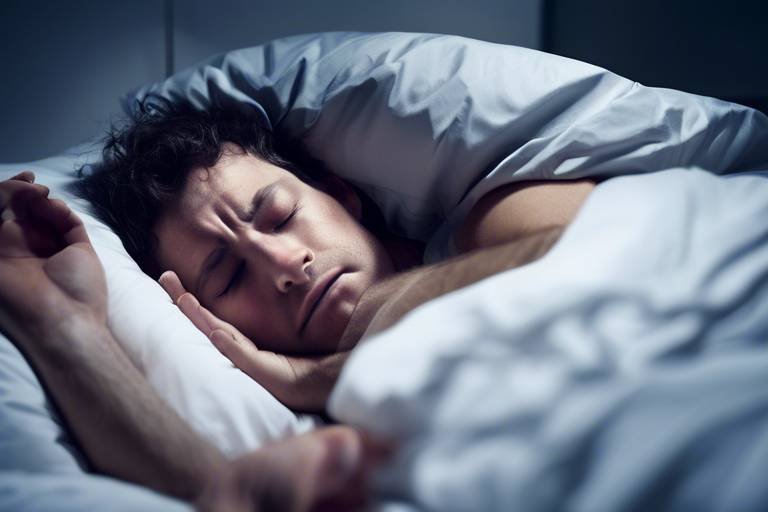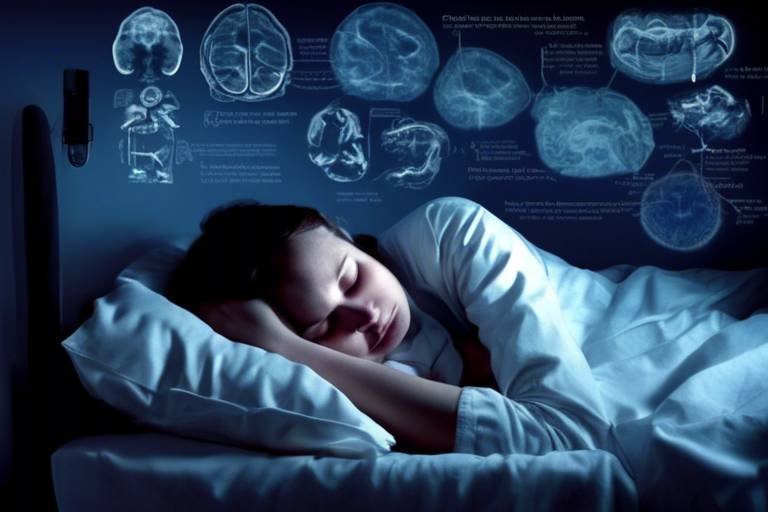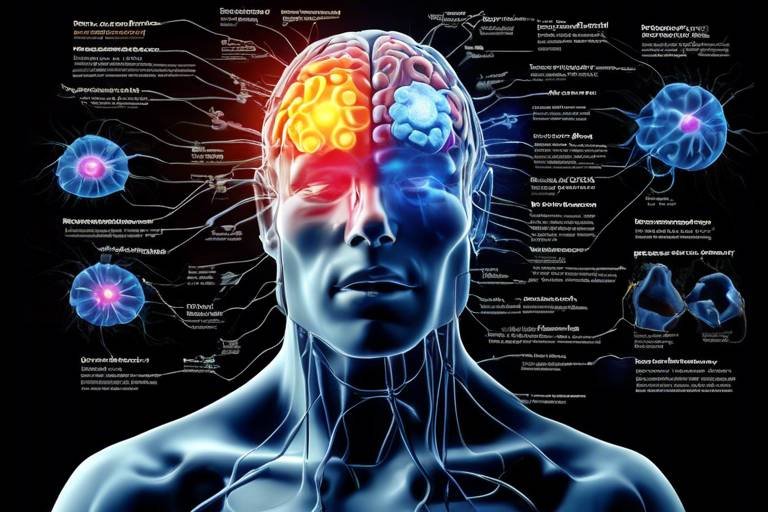The Physics of Balance - How Our Bodies Maintain Stability
Have you ever wondered how you can stand on one leg without toppling over or how you manage to walk on a narrow beam without losing your footing? The secret lies in the intricate mechanisms of balance within our bodies. Balance is not just a simple act of standing still; it is a complex interplay of various systems working in harmony to maintain stability in a constantly changing environment. In this article, we will delve into the fascinating world of balance, exploring the physical principles that allow us to navigate our daily lives with grace and poise.
The vestibular system plays a pivotal role in our ability to maintain balance. Nestled within the inner ear, this remarkable system provides essential sensory information about our spatial orientation and motion. Imagine it as a sophisticated GPS for your body, constantly sending signals to your brain about your position relative to gravity and movement. When you tilt your head or spin around, the vestibular system detects these changes and relays the information, allowing your body to adjust accordingly. Without this system, even the simplest tasks like standing or walking would become monumental challenges.
Another critical component of balance is proprioception, which refers to our body’s ability to sense its position and movement in space. Think of proprioception as your body’s internal compass, guiding you through various activities by providing feedback about where your limbs are and how they are moving. This sensory information is gathered from receptors located in our muscles, joints, and skin, allowing us to perform tasks like typing or playing sports with precision. When you close your eyes and touch your nose, it's proprioception that helps you accurately locate your finger, showcasing just how vital it is for maintaining balance and coordination.
Muscle coordination is another essential aspect of balance. Various muscle groups must work together seamlessly to stabilize the body during different activities. For instance, when you walk, the muscles in your legs, core, and even your arms coordinate to keep you upright and moving forward. If one muscle group is weak or uncoordinated, it can throw off your balance, leading to falls or injuries. Therefore, understanding how these muscle groups interact is crucial for developing effective balance training techniques.
Balance can be categorized into two types: dynamic and static. Dynamic balance refers to maintaining stability while in motion. Picture a dancer gracefully moving across the stage, effortlessly shifting their weight from one foot to another. In contrast, static balance is the ability to maintain stability while stationary, like standing on one leg. Both forms of balance are essential, and recognizing their differences can help us better understand how to improve our overall stability.
Improving balance is not just for athletes; it’s vital for individuals of all ages. There are numerous exercises and techniques designed to enhance balance. Some effective methods include:
- Yoga: This practice improves flexibility and strengthens core muscles, essential for balance.
- Tai Chi: Known for its slow, deliberate movements, Tai Chi enhances both dynamic and static balance.
- Balance Boards: Using balance boards can challenge your stability and improve coordination.
Incorporating these activities into your routine can lead to significant improvements in your balance, making everyday tasks easier and safer.
Did you know that your vision plays a crucial role in maintaining balance? Our eyes provide essential cues about our surroundings, helping us gauge distances and detect potential obstacles. When you walk into a room, your brain processes visual information alongside input from the vestibular system and proprioception to maintain stability. If your vision is impaired, it can significantly affect your balance, leading to an increased risk of falls. This interplay between vision and balance highlights the importance of regular eye check-ups and maintaining good vision health.
Balance disorders can disrupt daily life, affecting individuals of all ages. Conditions such as vertigo, Meniere's disease, and vestibular neuritis can lead to dizziness and instability. Understanding these disorders is essential for effective treatment and management. Below is a brief overview of some common balance disorders:
| Disorder | Symptoms | Treatment |
|---|---|---|
| Vertigo | Dizziness, spinning sensation | Vestibular rehabilitation, medications |
| Meniere's Disease | Hearing loss, ringing in the ears | Diet changes, medications |
| Vestibular Neuritis | Severe dizziness, balance issues | Medications, physical therapy |
Understanding the underlying causes of balance disorders is crucial for effective treatment. Factors such as age, neurological conditions, and inner ear issues can contribute to balance problems. As we age, our vestibular system may become less efficient, leading to an increased risk of falls. Additionally, conditions like Parkinson's disease or multiple sclerosis can disrupt the signals our brain receives, further complicating balance.
Fortunately, there are preventive measures that individuals can take to maintain balance as they age. Simple lifestyle changes, regular exercise, and therapies can promote stability and reduce the risk of falls. Engaging in activities that challenge your balance, such as dancing or hiking, can also be beneficial. Moreover, incorporating strength training exercises can enhance muscle coordination, making it easier to maintain balance in everyday situations.
Q: What can I do to improve my balance?
A: Incorporate balance exercises into your routine, such as yoga, Tai Chi, or using balance boards.
Q: Are balance disorders common?
A: Yes, balance disorders can affect individuals of all ages, but they are more prevalent in older adults.
Q: How can I prevent falls as I age?
A: Engage in regular exercise, maintain a healthy diet, and ensure your living environment is free of hazards.

The Role of the Vestibular System
The vestibular system is a complex and fascinating network located in our inner ear, playing a crucial role in maintaining balance and spatial orientation. Imagine trying to walk on a tightrope; the slightest miscalculation can lead to a tumble. This is where the vestibular system comes into play, constantly sending signals to the brain about our body's position in space and its movements. It consists of three semicircular canals filled with fluid, along with the otolith organs, which detect changes in acceleration and head position. Together, these components help us navigate through our environment, whether we’re standing still or engaged in vigorous activities.
When we move, the fluid in the semicircular canals shifts, sending information to our brain about the direction and speed of our movements. This feedback loop is vital for our sense of balance. For instance, when you spin around and then suddenly stop, it’s the vestibular system that helps your brain understand that you need to regain your equilibrium. Without this system, our sense of balance would be severely compromised, making simple tasks like walking or even standing extremely challenging.
What’s even more intriguing is how the vestibular system interacts with other sensory systems. It works in harmony with our visual system and proprioceptive feedback (the body's awareness of its position) to create a comprehensive understanding of our surroundings. For example, when you’re walking on uneven terrain, your eyes provide visual cues about the ground, while your vestibular system helps you maintain balance by detecting your head's movements. This integration is essential for performing daily activities safely and efficiently.
Moreover, the vestibular system is not just about keeping us upright; it also plays a role in our reflexes. When we lose our balance, this system triggers rapid adjustments in our muscle activity to help us regain stability. Think of it as a finely tuned orchestra where each instrument (or sensory input) must play in sync to create a harmonious performance. Any disruption in this system can lead to balance issues, making it vital for overall health and well-being.
In summary, the vestibular system is a remarkable aspect of human physiology, providing us with the necessary tools to maintain balance and navigate our world effectively. Understanding its functions can help us appreciate how intricate and interconnected our body's systems are. As we delve deeper into the mechanics of balance, it's essential to recognize the vestibular system's pivotal role in our daily lives.
- What is the vestibular system? The vestibular system is a sensory system located in the inner ear that helps maintain balance and spatial orientation.
- How does the vestibular system work? It detects head movements and position changes through fluid-filled canals and sends signals to the brain to help maintain balance.
- What happens if the vestibular system is damaged? Damage to this system can lead to balance disorders, dizziness, and coordination issues.
- Can the vestibular system be trained? Yes, specific exercises and therapies can enhance the function of the vestibular system and improve balance.

Proprioception and Body Awareness
Have you ever tried to walk in a dark room, and despite not being able to see, you managed to navigate without bumping into furniture? This incredible feat is largely due to a remarkable ability known as proprioception. Proprioception is the body's innate sense of its position and movement in space. It’s like having an internal GPS that helps you understand where your limbs are without needing to look. This sensory feedback is essential for maintaining balance and coordination, allowing us to perform everyday activities smoothly.
Imagine trying to balance on one leg while brushing your teeth. Your brain receives constant updates from various sensors in your muscles and joints, informing it about your body’s position. This information is vital for making quick adjustments to maintain stability. Proprioception works hand-in-hand with other senses, such as vision and the vestibular system, to create a comprehensive understanding of our body’s orientation. Without this intricate system, simple tasks could become incredibly challenging.
One of the fascinating aspects of proprioception is how it develops and evolves. As we grow, our proprioceptive abilities become more refined. Children, for instance, learn to coordinate their movements through play and exploration. Activities like running, jumping, and climbing help enhance their proprioceptive skills. In adults, these abilities remain crucial, especially in activities requiring precise movements, such as sports or dance.
Moreover, proprioception is not just about maintaining balance; it also plays a significant role in injury prevention. When we have a well-developed sense of body awareness, we are less likely to overextend our limbs or misjudge distances, which can lead to falls or strains. This is why athletes often engage in proprioceptive training to enhance their performance and reduce the risk of injury.
To illustrate the importance of proprioception, consider this: when you close your eyes and touch your nose with your finger, you rely on proprioceptive feedback to guide your movements. This simple action showcases how our body continuously communicates with our brain to ensure accuracy and stability. The more we practice and engage in activities that challenge our proprioceptive abilities, the better our body awareness becomes.
In conclusion, proprioception is a vital component of our overall balance and coordination. It enables us to move fluidly and with confidence, whether we are walking, running, or simply standing still. By understanding and improving our proprioceptive abilities, we can enhance our physical performance and maintain our stability well into our later years.

The Importance of Muscle Coordination
Muscle coordination is like the conductor of an orchestra, ensuring that each instrument plays in harmony to create a beautiful symphony. In the context of balance, this coordination is crucial for our ability to maintain stability during various activities, from walking and running to standing still. When we move, multiple muscle groups must work together seamlessly, adjusting and responding to shifts in our body position. Imagine trying to balance on a tightrope; if one muscle group is out of sync, it can throw off the entire act, leading to a fall.
At the heart of muscle coordination is the central nervous system, which sends signals to muscles to contract or relax in a precise sequence. This intricate communication allows us to perform complex movements effortlessly. For instance, when you reach out to grab a cup, your brain simultaneously engages the muscles in your arm, shoulder, and even your core to stabilize your body. Without this coordination, even the simplest tasks could become challenging, leaving us susceptible to losing our balance.
The relationship between muscle coordination and balance can be broken down into several key components:
- Muscle Synergy: Different muscle groups must work together to produce smooth and controlled movements. For example, when you walk, your leg muscles, core, and even your arms must coordinate to maintain your center of gravity.
- Reaction Time: Quick responses to unexpected changes, such as stumbling or tripping, rely heavily on muscle coordination. The faster your muscles can react, the better your chances of regaining balance.
- Strength and Flexibility: Strong and flexible muscles are essential for good coordination. They allow for a greater range of motion and the ability to adapt to various physical demands.
Furthermore, the importance of muscle coordination extends beyond just physical activities. It plays a significant role in our daily lives. Think about how much we rely on coordinated movements when performing tasks such as typing, driving, or even dancing. Each of these activities requires a complex interplay between different muscle groups, highlighting just how vital coordination is to our overall function and stability.
To improve muscle coordination, various exercises can be beneficial. Activities like yoga, pilates, and balance training not only enhance strength but also promote better communication between the brain and muscles. These practices encourage the body to work as a cohesive unit, improving overall stability and reducing the risk of falls. So, whether you’re an athlete looking to enhance performance or someone simply trying to maintain independence as you age, focusing on muscle coordination is essential.
In conclusion, muscle coordination is a fundamental aspect of maintaining balance. It is the intricate dance of our muscles working in unison, allowing us to navigate our environment with grace and stability. By understanding and training this coordination, we can enhance our balance and improve our quality of life.
- What is muscle coordination? Muscle coordination refers to the ability of different muscle groups to work together effectively to perform movements and maintain balance.
- How can I improve my muscle coordination? Engaging in activities like yoga, pilates, and balance training can significantly enhance muscle coordination.
- Why is muscle coordination important for balance? Proper muscle coordination allows for smooth movements and quick reactions to changes in body position, which are essential for maintaining balance.

Dynamic vs. Static Balance
When we think about balance, it’s essential to understand that it can be categorized into two main types: dynamic balance and static balance. Each type plays a unique role in how we navigate our world, and recognizing the differences can help us appreciate the complexity of our body’s mechanics. So, what exactly do these terms mean? Let’s break it down!
Dynamic balance refers to our ability to maintain stability while in motion. Imagine a tightrope walker gracefully traversing a thin wire high above the ground. Every step they take requires incredible coordination and balance as they adjust to the shifting forces acting on their body. Dynamic balance is crucial in activities such as running, dancing, or even walking on uneven surfaces. Our bodies constantly receive feedback from our muscles, joints, and sensory systems to help us stay upright and avoid falling.
On the other hand, static balance involves maintaining stability while stationary. Picture yourself standing on one leg while waiting for the bus. This requires a different set of skills compared to dynamic balance. In static balance, your body must engage specific muscle groups to hold your position without wobbling or collapsing. This type of balance is vital for tasks like standing still, holding a yoga pose, or even just sitting at a desk. It’s all about finding that sweet spot where your center of gravity aligns with your base of support.
To further illustrate the differences, let’s take a look at some key characteristics of dynamic and static balance in the table below:
| Characteristic | Dynamic Balance | Static Balance |
|---|---|---|
| Definition | Maintaining stability while moving | Maintaining stability while stationary |
| Examples | Running, dancing, cycling | Standing on one leg, yoga poses |
| Muscle Engagement | Requires continuous adjustments | Requires sustained muscle contraction |
| Feedback Mechanism | Utilizes proprioception and vestibular inputs | Primarily relies on proprioception |
Understanding the distinction between dynamic and static balance is not just an academic exercise; it has practical implications for our daily lives. For instance, athletes often train to enhance their dynamic balance to improve performance in their respective sports. Meanwhile, older adults might focus on static balance exercises to reduce the risk of falls, which can be devastating. By recognizing the importance of both types of balance, we can tailor our training and activities to better suit our needs.
In conclusion, whether you’re dancing at a party or simply trying to stand on one leg, both dynamic and static balance are essential for maintaining stability in our lives. By honing these skills, we can improve our overall coordination, prevent injuries, and enjoy a more active lifestyle. So, the next time you find yourself balancing, remember that there's a fascinating world of physics at play!

Balance Training Techniques
When it comes to mastering balance, the journey is as thrilling as a tightrope walk across a bustling street! Balance training techniques are not just for athletes; they are essential for everyone, from toddlers learning to walk to seniors aiming to maintain their independence. These exercises enhance stability, coordination, and overall body awareness. So, let’s dive into the world of balance training and explore how we can strengthen our foundation.
One of the most effective balance training techniques is the use of stability balls. These inflatable spheres challenge your core muscles, forcing them to engage while you perform various movements. Imagine sitting on a ball while typing on your computer; it’s not just a fun way to spice up your workspace, but it also helps improve your posture and balance. Incorporating stability ball exercises, such as wall squats or seated bounces, can significantly enhance your balance.
Another fantastic method is balance boards, which provide a dynamic surface that requires constant adjustment to maintain stability. Think of it as surfing on dry land! These boards can be used for simple exercises like standing on one leg or more complex movements like squats. They engage multiple muscle groups and improve proprioception, which is crucial for balance. For beginners, starting with a wobble board can be a game-changer, as it allows for gradual progression.
For those who prefer a more structured approach, yoga and tai chi are excellent choices. Both practices emphasize body awareness and control. In yoga, poses like the Tree Pose or Warrior III challenge your balance while promoting strength and flexibility. Tai chi, often described as “meditation in motion,” involves slow, deliberate movements that enhance coordination and stability. Engaging in these practices regularly can lead to significant improvements in balance and overall well-being.
In addition to these methods, incorporating simple daily activities can also boost your balance. For instance, try standing on one leg while brushing your teeth or walking heel-to-toe in a straight line. These small adjustments can make a big difference over time. Remember, balance is not just about standing still; it’s about moving with grace and control, whether you’re dancing at a party or navigating through a crowded market.
To maximize the effectiveness of your balance training, consider these tips:
- Consistency is key: Aim for at least 15-30 minutes of balance training several times a week.
- Focus on your core: A strong core is essential for maintaining stability, so include core-strengthening exercises in your routine.
- Challenge yourself: Gradually increase the difficulty of your exercises by closing your eyes or adding movement.
In conclusion, balance training techniques are vital for everyone, regardless of age or fitness level. By incorporating stability balls, balance boards, yoga, and tai chi into your routine, you can significantly improve your stability and coordination. Remember, the goal is to make balance training a fun and engaging part of your daily life. So, why not take the plunge and start your balance training journey today?
1. How often should I practice balance exercises?
It’s recommended to practice balance exercises at least 2-3 times a week for optimal results. Consistency is crucial for improvement.
2. Can balance training help prevent falls?
Absolutely! Regular balance training strengthens the muscles needed for stability and enhances your overall coordination, significantly reducing the risk of falls.
3. Do I need any special equipment for balance training?
While some exercises can be performed with equipment like stability balls and balance boards, many effective balance exercises can be done using just your body weight.
4. Is balance training suitable for seniors?
Yes, balance training is especially beneficial for seniors as it helps maintain independence, improves mobility, and reduces the risk of falls.
5. How long will it take to see improvements in my balance?
With regular practice, many individuals notice improvements in their balance within a few weeks. However, results can vary based on individual fitness levels and consistency.

Impact of Vision on Balance
Vision plays a crucial role in maintaining our balance, acting as one of the key senses that help us navigate through our environment. Imagine trying to walk on a tightrope without being able to see where you’re going; it would be nearly impossible, right? Our eyes provide important cues about our surroundings, allowing us to make quick adjustments to our posture and movements. When we move, our visual system works in conjunction with other sensory systems, such as the vestibular and proprioceptive systems, to create a comprehensive understanding of our body's position in space.
When we talk about balance, we often think of it as a physical skill, but it’s also a complex interplay of sensory information. The visual system contributes to balance by providing feedback on:
- Spatial Orientation: Helping us perceive the position of our body relative to the environment.
- Motion Detection: Allowing us to see how fast we are moving and in what direction.
- Depth Perception: Enabling us to judge distances accurately, which is essential for preventing falls.
Research has shown that when we are in unfamiliar environments or when our vision is compromised, our balance can be significantly affected. For instance, when walking in dim light or on uneven surfaces, our reliance on visual cues increases. This reliance can sometimes lead to disorientation if the visual information is conflicting or unclear. Consider a situation where you’re walking on a rocky path at dusk; your brain is processing the limited visual information, which may lead to a temporary loss of balance as it struggles to interpret the terrain accurately.
Moreover, certain visual disorders can have a direct impact on balance. Conditions such as cataracts, glaucoma, or even age-related macular degeneration can impair vision, making it more challenging to maintain stability. Individuals with these conditions often experience difficulties in judging distances or detecting obstacles, which can increase the risk of falls. To illustrate this, a study found that older adults with visual impairments were more likely to experience falls compared to their peers with normal vision. This connection between vision and balance underscores the importance of regular eye check-ups and corrective measures, such as glasses or contact lenses, to enhance visual acuity.
In conclusion, the integration of visual information with other sensory inputs is essential for maintaining balance. As we age or experience changes in our vision, it’s important to be aware of how these factors can affect our stability. Keeping our eyes healthy and ensuring that we adapt our surroundings to be as safe as possible are key steps in preventing balance-related issues. So next time you find yourself feeling a little wobbly, take a moment to check your surroundings and ensure your vision is up to par!
- How does vision affect balance? Vision provides essential cues about our surroundings, helping us maintain stability and navigate effectively.
- What are common visual impairments that can affect balance? Conditions like cataracts, glaucoma, and macular degeneration can impair vision and increase the risk of falls.
- What can I do to improve my balance? Regular eye check-ups, balance exercises, and ensuring a safe environment can help improve stability.

Common Balance Disorders
Balance disorders can significantly impact an individual's quality of life, making even simple tasks like walking or standing feel like navigating a tightrope. These disorders can arise from various underlying issues, and understanding them is crucial for effective management and treatment. Common balance disorders include vestibular dysfunction, peripheral neuropathy, and cerebellar ataxia. Each of these conditions affects the body's ability to maintain stability in different ways, often leading to dizziness, unsteadiness, and a heightened risk of falls.
The vestibular system, located in the inner ear, plays a fundamental role in our sense of balance. When this system is compromised, individuals may experience vertigo, a sensation that they or their surroundings are spinning. This can be incredibly disorienting and is often associated with conditions such as BPPV (Benign Paroxysmal Positional Vertigo) or vestibular neuritis. On the other hand, peripheral neuropathy, which affects the nerves outside the brain and spinal cord, can lead to a loss of sensation in the feet and legs, making it difficult to gauge body position and movement. This can result in a staggering gait and increased fall risk.
Cerebellar ataxia, another common balance disorder, stems from dysfunction in the cerebellum, the part of the brain responsible for coordinating movement. Individuals with this condition may find it challenging to control their movements, leading to a wobbly or unsteady gait. The symptoms can vary widely, with some experiencing mild instability while others may struggle to stand or walk without assistance.
To better understand these disorders, let's take a look at a summary of common balance disorders, their causes, and symptoms in the table below:
| Balance Disorder | Causes | Symptoms |
|---|---|---|
| Vestibular Dysfunction | Inner ear issues, infections, head injuries | Dizziness, vertigo, imbalance |
| Peripheral Neuropathy | Diabetes, alcohol abuse, certain medications | Numbness, tingling, unsteady gait |
| Cerebellar Ataxia | Genetic disorders, stroke, tumors | Wobbly movements, difficulty with coordination |
Recognizing the symptoms of these disorders is the first step toward seeking help. If you or someone you know is experiencing persistent balance issues, it’s essential to consult a healthcare professional. They can provide a thorough evaluation and recommend appropriate treatment options, which may include physical therapy, medication, or lifestyle modifications.
Furthermore, preventive measures can play a significant role in managing balance disorders. Engaging in regular exercise, maintaining a healthy diet, and staying hydrated can help improve overall stability. Additionally, incorporating balance training exercises into your routine can enhance proprioception and muscle coordination, reducing the risk of falls.
In conclusion, balance disorders can pose significant challenges, but with the right knowledge and intervention, individuals can manage their symptoms effectively. Awareness of the different types of balance disorders and their implications is crucial for maintaining a healthy, active lifestyle.
1. What are the most common symptoms of balance disorders?
Common symptoms include dizziness, vertigo, unsteadiness, and difficulty walking or standing. Some individuals may also experience a sensation of spinning or lightheadedness.
2. How are balance disorders diagnosed?
Diagnosis typically involves a thorough medical history, physical examinations, and various tests such as balance assessments, hearing tests, and imaging studies to identify the underlying cause.
3. Can balance disorders be treated?
Yes, treatment options vary depending on the specific disorder but may include physical therapy, medications, and lifestyle changes aimed at improving balance and stability.
4. Are there exercises to improve balance?
Absolutely! Exercises such as tai chi, yoga, and specific balance training routines can help enhance stability and coordination.
5. What preventive measures can I take to maintain balance?
Staying active, maintaining a healthy diet, and incorporating balance exercises into your routine can significantly reduce the risk of falls and help maintain stability.

Causes of Balance Disorders
Balance disorders can stem from a variety of factors, each contributing to the delicate equilibrium our bodies maintain every day. Understanding these causes is crucial for effective treatment and management. One major contributor to balance issues is age. As we grow older, the body's systems that regulate balance naturally decline. This decline can lead to a decreased ability to respond to changes in position, making falls more likely.
Another significant factor is neurological conditions. Disorders such as Parkinson's disease, multiple sclerosis, and stroke can severely impact the brain's ability to process sensory information, which is essential for maintaining balance. These conditions can disrupt the communication between the brain and the body, leading to instability.
Furthermore, issues with the inner ear can also play a pivotal role. The inner ear houses the vestibular system, which is responsible for detecting motion and maintaining balance. Conditions such as benign paroxysmal positional vertigo (BPPV), Meniere's disease, or vestibular neuritis can cause dizziness and a distorted sense of balance. In fact, the inner ear's health is so critical that even minor infections can lead to significant balance impairments.
Other contributing factors include:
- Medications: Certain medications can have side effects that affect balance, such as dizziness or drowsiness.
- Vision problems: Since vision is a key component in maintaining balance, any impairment can lead to difficulties. Conditions like cataracts or macular degeneration can hinder visual input.
- Muscle weakness: Weakness in the legs or core muscles can directly affect stability, making it harder to maintain balance.
In addition to these factors, environmental hazards such as uneven surfaces, poor lighting, and clutter can also contribute to falls and balance disorders. Understanding these causes allows healthcare professionals to tailor specific interventions aimed at improving balance and reducing the risk of falls.
In summary, balance disorders arise from a complex interplay of age, neurological conditions, inner ear issues, medications, vision problems, and environmental factors. By addressing these underlying causes, individuals can take proactive steps towards improving their stability and overall quality of life.
1. What are common symptoms of balance disorders?
Common symptoms include dizziness, lightheadedness, unsteadiness, and a feeling of being off-balance. Some individuals may also experience vertigo, which is a sensation that you or your surroundings are spinning.
2. How are balance disorders diagnosed?
Diagnosis typically involves a comprehensive evaluation, which may include a physical examination, balance tests, hearing tests, and imaging studies to assess the inner ear and brain function.
3. Can balance disorders be treated?
Yes, treatment options vary depending on the underlying cause but may include physical therapy, medications, lifestyle changes, and in some cases, surgery.
4. Are there exercises to improve balance?
Absolutely! Exercises such as tai chi, yoga, and specific balance training routines can significantly enhance stability, especially for older adults.
5. How can I prevent balance disorders?
Preventive measures include regular exercise, maintaining a healthy diet, getting regular eye exams, and managing chronic conditions effectively. It's also important to create a safe living environment to minimize fall risks.

Preventive Measures for Maintaining Balance
Maintaining balance is essential for everyone, especially as we age. The good news is that there are numerous preventive measures individuals can adopt to enhance their stability and reduce the risk of falls. First and foremost, engaging in regular physical activity is crucial. Exercise not only strengthens muscles but also improves coordination and flexibility, making it easier for our bodies to adapt to different situations. Activities like yoga, tai chi, and even simple stretching can be incredibly beneficial.
In addition to physical activity, it's vital to pay attention to your environment. Ensuring that your living space is safe can significantly reduce the chances of falls. This includes keeping floors clear of clutter, using non-slip mats, and ensuring that lighting is adequate. Did you know that poor lighting can contribute to missteps? It's like trying to navigate a dark room; you might trip over something you can't see!
Moreover, incorporating balance-specific exercises into your routine can yield fantastic results. These exercises can help improve proprioception and muscle coordination. Some effective exercises include:
- Single-leg stands: Try standing on one leg for 10-30 seconds, then switch.
- Heel-to-toe walk: Walk in a straight line, placing the heel of one foot directly in front of the toes of the other.
- Balance board exercises: Using a balance board can challenge your stability and improve core strength.
Nutrition also plays a subtle yet significant role in maintaining balance. A diet rich in calcium and vitamin D can help strengthen bones and prevent fractures. Foods like dairy products, green leafy vegetables, and fish should be staples in your diet. Staying hydrated is equally important; dehydration can lead to dizziness, which can throw off your balance.
Another preventive measure is to regularly review medications with your healthcare provider. Some medications can affect balance and coordination, so it’s wise to discuss any concerns you may have. This proactive approach can help you avoid potential side effects that could compromise your stability.
Finally, consider engaging in balance training classes or working with a physical therapist. These professionals can tailor programs specifically for your needs, ensuring you're on the right path to maintaining your balance. Remember, taking small steps today can lead to significant improvements tomorrow. Just like training for a marathon, consistency is key!
Q: What are some simple exercises I can do at home to improve my balance?
A: Some simple exercises include single-leg stands, heel-to-toe walking, and practicing tai chi or yoga. These can be done in the comfort of your home and require minimal equipment.
Q: How often should I practice balance exercises?
A: Aim to practice balance exercises at least 2-3 times a week. Consistency is essential for improvement!
Q: Can my diet really affect my balance?
A: Absolutely! A well-balanced diet rich in calcium, vitamin D, and hydration can support bone health and overall stability.
Q: When should I seek professional help for balance issues?
A: If you experience frequent falls, dizziness, or any sudden changes in your balance, it’s important to consult with a healthcare professional to rule out any underlying conditions.
Frequently Asked Questions
- What is the vestibular system and how does it affect balance?
The vestibular system is a complex structure located in the inner ear that helps us maintain our balance by providing information about our body's position in space. It detects changes in head movement and orientation, allowing us to adjust our posture and movements accordingly. Without a properly functioning vestibular system, maintaining balance would be incredibly challenging, leading to dizziness and instability.
- How does proprioception contribute to balance?
Proprioception is our body's ability to sense its position and movement without relying on visual cues. It plays a crucial role in balance by allowing us to make adjustments based on feedback from our muscles and joints. For instance, when you close your eyes and stand on one leg, proprioception helps you stay upright by informing your brain about your body's position, enabling subtle muscle adjustments to maintain stability.
- What are the differences between dynamic and static balance?
Dynamic balance refers to our ability to maintain stability while in motion, such as walking or running, where our center of gravity shifts frequently. Static balance, on the other hand, is about maintaining stability when stationary, like standing still on one leg. Both types of balance require different muscle coordination and sensory input, making them essential for various activities in our daily lives.
- What exercises can improve balance?
There are numerous exercises designed to enhance balance, including:
- Single-leg stands
- Heel-to-toe walks
- Yoga and tai chi
- Balance board exercises
- Strength training focused on core stability
Incorporating these exercises into your routine can significantly improve your balance and coordination, benefiting individuals of all ages.
- How does vision impact balance?
Vision plays a vital role in maintaining balance by providing essential information about our surroundings. Our eyes help us gauge distances, detect movement, and understand spatial orientation. When visual input is compromised, such as in dim lighting or with certain eye conditions, it can lead to balance issues. This is why integrating visual cues with other sensory inputs, like vestibular and proprioceptive feedback, is crucial for stability.
- What are common balance disorders?
Common balance disorders include conditions like vertigo, Meniere's disease, and vestibular neuritis. These disorders can disrupt our ability to maintain stability and may lead to frequent falls or dizziness. Treatment options vary based on the underlying cause and may include medication, physical therapy, or lifestyle changes to help manage symptoms effectively.
- What causes balance disorders?
Balance disorders can arise from various factors, including:
- Aging
- Neurological conditions (like Parkinson's disease)
- Inner ear issues (such as infections or fluid buildup)
- Medication side effects
Understanding these causes is essential for effective diagnosis and treatment.
- How can I prevent balance issues as I age?
Preventive measures for maintaining balance include engaging in regular physical activity, practicing balance exercises, and making lifestyle changes like improving home safety to reduce fall risks. Staying active not only strengthens muscles but also enhances proprioception and coordination, helping you maintain stability as you age.



















